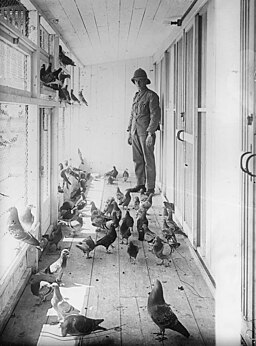The first homing pigeons were used by the Egyptians 3000 years ago.
The idea of using a pigeon to send messages obviously was not new to Army troops during World War I. They proved an excellent means of communicating for all sides throughout the war.
Some 100,000 pigeons were used and, according to Pigeons and World War I, they got through 95% of the time. They were so important, the British government moved quickly to secure native pigeons for the Allied side once the war began.
In the early days of the war when Britain was worried about invasion and German spies, the British government shut down all communication to the enemy side. As a result, many people believed the only way agents provocateur could send messages to Germany was through the use of carrier pigeons. For that reason, all pigeons along the eastern coast of England were confiscated.
Some naturalized Germans were hauled before police courts and penalized for owning homing pigeons.One man, Anton Lambert, was sentenced to six months of hard labor for having 24 homing pigeons in his possession.
Targets
The birds needed to be turned in. To shoot, kill, wound or molest homing pigeons could bring a six months sentence and/or a 100 pound fine.
Chances of a shot hitting them, however, were slim, according to Pigeons in WWI:
“A pigeon’s great strength was not only its extraordinary homing instinct but also the speed at which it flew. Shooting one down would have been all but impossible. . . . . A falcon could bring down a pigeon – a marksman almost certainly could not.”
The birds were usually sent from the Front, tossed aloft with small metal cannisters “banded” to their legs. They’d fly back to their home coop, often a series of baskets maintained behind the enemy lines, perhaps as far as several miles away. Once landed, the cannister would be removed, the message read and information sent on to the necessary command.
Information carried by birds was used to target artillery, inform of casualties, or other battle-related information. They were the primary source of intelligence on many battlefields.
Britain’s Emergency Pigeon Service was established when homing pigeons were given to minesweepers. Using the birds, information could be sent about newly laid minefields and other dangers.
Pigeons have traveled as far as 1800 miles, at speeds around 50 miles per hour but they can fly up to 90 miles per hour in desperate situations.
Not only boats and soldiers, but tanks carried pigeons. Other communication was too primitive one hundred years ago and without radios, pigeons were the only means of sending messages effectively. The Royal Flying Corps, Royal Air Force and Royal Naval Air Service all used pigeons to send messages from airplanes back to ground bases.
American flyers
The US Army Signal Corps deployed 600 in France alone, once they arrived in 1918.
The US Navy had 72 lofts housing more than 1500 pigeons by the end of World War I.
Releasing a pigeon from a tank IWM Q9247“Pigeons were carried in airplanes to rapidly return messages to these stations; and 829 birds flew in 10,995 wartime aircraft patrols. Airmen of the 230 patrols with messages entrusted to pigeons threw the message-carrying pigeon either up or down, depending on the type of aircraft, to keep the pigeon out of the propeller and away from airflow toward the aircraft wings and struts.
Eleven of the thrown pigeons went missing in action, but the remaining 219 messages were delivered successfully.”
(Pigeons were considered so necessary to the Navy that when they built an aircraft carrier in 1922, they included a pigeon loft on board!)
Creativity in their use was limited only by the birds themselves. The Germans even outfitted pigeons with tiny cameras, but how effective they were as photographers remains a mystery.
And you thought pigeons were only nuisances in the park . . .
TweetablesPigeons in WWI; eyes on the battlefield, wings in air Click to Tweet
The importance of pigeon intelligence during WWI for all sides. Click to Tweet
Why 100,000 pigeons flew for Britain during WWI. Click to Tweet









Thoughts? Reactions? Lurker?